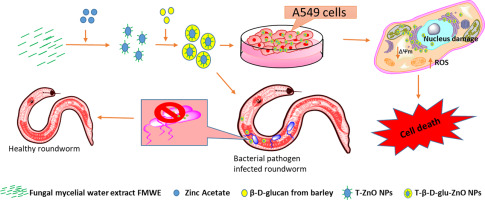当前位置:
X-MOL 学术
›
J. Photochem. Photobiol. B Biol.
›
论文详情
Our official English website, www.x-mol.net, welcomes your
feedback! (Note: you will need to create a separate account there.)
Enhanced anti-lung carcinoma and anti-biofilm activity of fungal molecules mediated biogenic zinc oxide nanoparticles conjugated with β-D-glucan from barley.
Journal of Photochemistry and Photobiology B: Biology ( IF 3.9 ) Pub Date : 2019-12-03 , DOI: 10.1016/j.jphotobiol.2019.111728 Kandasamy Saravanakumar 1 , Elango Jeevithan 2 , Xiaowen Hu 1 , Ramachandran Chelliah 3 , Deog-Hwan Oh 3 , Myeong-Hyeon Wang 1
Journal of Photochemistry and Photobiology B: Biology ( IF 3.9 ) Pub Date : 2019-12-03 , DOI: 10.1016/j.jphotobiol.2019.111728 Kandasamy Saravanakumar 1 , Elango Jeevithan 2 , Xiaowen Hu 1 , Ramachandran Chelliah 3 , Deog-Hwan Oh 3 , Myeong-Hyeon Wang 1
Affiliation

|
This work reports the optimization, synthesis, characterization, anticancer, and antibacterial activity of the Trichoderma-β-D-glucan‑zinc oxide nanoparticles (T-β-D-glu-ZnO NPs). Firstly, the T-ZnO NPs was synthesized using the fungal mycellial water extract (FWME) derived from T. harzianum (SKCGW009) under the optimized condition of extract concentration (5.99 mL), temperature (43.11 °C), pH (8) and time (69.04 h). The successful conjugation of T-ZnO NPs with β-D-glucan (T-β-D-glu-ZnO NPs) was confirmed by PACE and FTIR. The XRD, UHR SEM, and TEM EDS results pointed the spherical shape of NPs with the mean size of 30.34 nm. Further, the XPS survey scan and high-resolution fitting of Zn2p results also claimed the successful formation of the T-β-D-glu-ZnO NPs. Cytotoxicity results indicated that the NPs were not toxic to NIH3T3 cells, while exhibited the dose-dependent inhibitory effect to human pulmonary carcinoma A549 cells. The IC50 of T-ZnO NPs and T-β-D-glu-ZnO NPs against A549 cells was 158 and 56.25 μg.mL-1, respectively, which was also verified by fluorescent cytochemistry. Annexin V-FITC staining results indicated the presence of apoptotic cells in the NPs treated A549 cells, which was not seen in the non-treated control A549 cells. Interestingly, the number of necrosis cells was higher in the T-ZnO NPs (3.38%) comparing to T-β-D-glu -ZnO NPs (0.07%). The early or late apoptosis was found higher in the cells treated T-β-D-glu -ZnO NPs (6.43%) comparing with T-ZnO NPs (4%). These results indicated that T-ZnO NPs and T-β-D-glu-ZnO NPs induced the cancer cell death through necrosis and apoptosis pathway, respectively. The antibacterial results indicated that the NPs treatment were significantly inhibited the growth of the Staphylococcus aureus inside of roundworm and enhanced growth of roundworm. Overall, anticancer and in vitro, in vivo antibacterial studies proved the high caliber of T-β-D-glu-ZnO NPs for the further pharmaceutical evaluation.
中文翻译:

大麦中与β-D-葡聚糖偶联的真菌分子介导的生物氧化锌纳米颗粒的抗肺癌活性和抗生物膜活性增强。
这项工作报告了木霉-β-D-葡聚糖-氧化锌纳米颗粒(T-β-D-glu-ZnONPs)的优化,合成,表征,抗癌和抗菌活性。首先,在最佳提取液浓度(5.99 mL),温度(43.11°C),pH(8)和最佳条件下,使用哈茨木霉(T. harzianum)的真菌菌丝水提取物(FWME)合成T-ZnO NPs(SKCGW009)。时间(69.04小时)。通过PACE和FTIR证实了T-ZnO NP与β-D-葡聚糖(T-β-D-glu-ZnONP)的成功偶联。XRD,UHR SEM和TEM EDS结果表明NP的球形,平均尺寸为30.34 nm。此外,XPS调查扫描和Zn2p结果的高分辨率拟合也声称成功形成了T-β-D-glu-ZnONP。细胞毒性结果表明NP对NIH3T3细胞无毒性,而对人肺癌A549细胞则表现出剂量依赖性的抑制作用。T-ZnO NPs和T-β-D-glu-ZnONPs对A549细胞的IC50分别为158和56.25μg.mL-1。膜联蛋白V-FITC染色结果表明在经NPs处理的A549细胞中存在凋亡细胞,这在未处理的对照A549细胞中未见。有趣的是,与T-β-D-glu-ZnONPs(0.07%)相比,T-ZnO NPs中的坏死细胞数量更高(3.38%)。在处理过的T-β-D-glu-ZnO NPs中,发现早期或晚期细胞凋亡更高(6.43%),而T-ZnO NPs(4%)更高。这些结果表明,T-ZnO NPs和T-β-D-glu-ZnONPs分别通过坏死和凋亡途径诱导癌细胞死亡。抗菌结果表明,NPs处理能显着抑制round虫体内金黄色葡萄球菌的生长,并增强of虫的生长。总体而言,抗癌和体外,体内抗菌研究证明,T-β-D-glu-ZnONP具有很高的口径,可用于进一步的药物评估。
更新日期:2019-12-04
中文翻译:

大麦中与β-D-葡聚糖偶联的真菌分子介导的生物氧化锌纳米颗粒的抗肺癌活性和抗生物膜活性增强。
这项工作报告了木霉-β-D-葡聚糖-氧化锌纳米颗粒(T-β-D-glu-ZnONPs)的优化,合成,表征,抗癌和抗菌活性。首先,在最佳提取液浓度(5.99 mL),温度(43.11°C),pH(8)和最佳条件下,使用哈茨木霉(T. harzianum)的真菌菌丝水提取物(FWME)合成T-ZnO NPs(SKCGW009)。时间(69.04小时)。通过PACE和FTIR证实了T-ZnO NP与β-D-葡聚糖(T-β-D-glu-ZnONP)的成功偶联。XRD,UHR SEM和TEM EDS结果表明NP的球形,平均尺寸为30.34 nm。此外,XPS调查扫描和Zn2p结果的高分辨率拟合也声称成功形成了T-β-D-glu-ZnONP。细胞毒性结果表明NP对NIH3T3细胞无毒性,而对人肺癌A549细胞则表现出剂量依赖性的抑制作用。T-ZnO NPs和T-β-D-glu-ZnONPs对A549细胞的IC50分别为158和56.25μg.mL-1。膜联蛋白V-FITC染色结果表明在经NPs处理的A549细胞中存在凋亡细胞,这在未处理的对照A549细胞中未见。有趣的是,与T-β-D-glu-ZnONPs(0.07%)相比,T-ZnO NPs中的坏死细胞数量更高(3.38%)。在处理过的T-β-D-glu-ZnO NPs中,发现早期或晚期细胞凋亡更高(6.43%),而T-ZnO NPs(4%)更高。这些结果表明,T-ZnO NPs和T-β-D-glu-ZnONPs分别通过坏死和凋亡途径诱导癌细胞死亡。抗菌结果表明,NPs处理能显着抑制round虫体内金黄色葡萄球菌的生长,并增强of虫的生长。总体而言,抗癌和体外,体内抗菌研究证明,T-β-D-glu-ZnONP具有很高的口径,可用于进一步的药物评估。











































 京公网安备 11010802027423号
京公网安备 11010802027423号